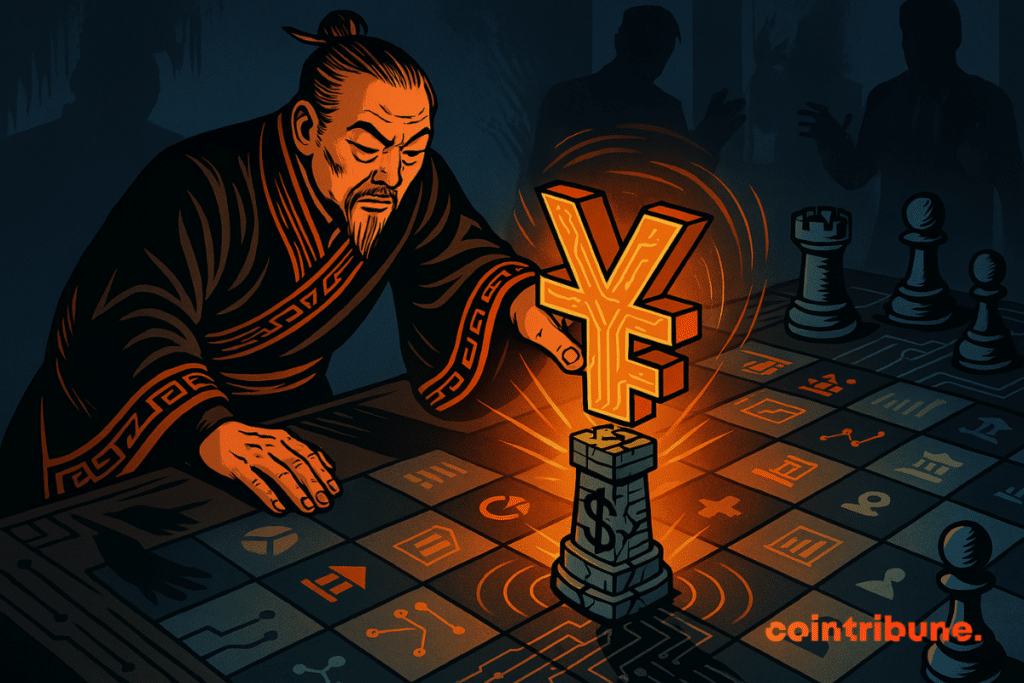9h05 ▪
5
min read ▪ by
There was a time, not so long ago, when Donald Trump thundered: any country daring to build a future without the dollar would be punished by an avalanche of tariffs. Tax, sanction, isolate: that was the warning to anyone deviating from the green axis. But within the BRICS, the threat rings hollow. China, however, does not respond with bombs or missiles. It draws another weapon: its digital currency, the digital yuan or e-CNY. Not a currency war, but another map of global finance.

In brief
The digital yuan serves as a strategic tool for China to reshape current international finance.
China is deploying the e-CNY regionally through CIPS, UnionPay, and mBridge.
261 million users have already adopted the digital yuan in Chinese public services and commerce.
Western sanctions are circumvented through the digital yuan in oil, gold, and swaps.
Digital Yuan: China plays its card in financial geopolitics
In Shanghai, the Governor of the People’s Bank of China, Pan Gongsheng, set the tone. Against the backdrop of trade tensions with the USA, he wants to build a multipolar monetary system. Less dollar, more balance. At the Lujiazui Forum, he stated:
Developing a multipolar international monetary system will help strengthen global financial stability.
The core of the system: an international management center for the e-CNY, backed by the CIPS system, an alternative to the SWIFT network. Banks like Standard Bank and First Abu Dhabi Bank have already joined.
Pan also denounces current flaws: “Cross-border payment infrastructures can be politicized and used as tools for unilateral sanctions.” Finance is no longer neutral; it becomes a battlefield.
The e-CNY allows China to secure its transactions while avoiding the dollar. It is an economic maneuver, but also a diplomatic one. Because where the United States isolates, Beijing weaves ties: Russia, Iran, Persian Gulf. The digital currency becomes an alternative to hegemony.
Liquid finance: massive adoption and daily usage
In the streets of China, the e-CNY is already a reality. More than 261 million users use it, with a cumulative volume exceeding 7.3 trillion dollars (Blockhead). Daily life is converting: transportation, salaries, taxes. No need for a bank account. A QR code is enough, even offline.
In Jiangsu, officials are paid in digital yuan. In Chengdu, it is used at the market. It is no longer an experiment. It is a digital reflex. Even tourists have access via a simple mobile app.
But Beijing’s ambition goes beyond its borders. UnionPay, supported by the PBoC, is rolling out QR payments in Southeast Asia. Cambodia, Vietnam, Laos: the ecosystem is exported. Thanks to mBridge, transactions between Hong Kong and Abu Dhabi settle in 7 seconds, with a 98% reduced cost (Blockhead).
On X, Josh Ryan-Collins writes:
Central bank digital currencies could increase public profits derived from seigniorage.
More than just a technology, the digital yuan becomes a fiscal and political lever.
Global finance: when Beijing destabilizes the established order
The digital yuan is not just a monetary gadget. It is a strategic instrument that redraws balances in regions seeking emancipation from the dollar. Beijing does not claim this. It proves it:
3rd currency for global payments, according to SWIFT;
2nd currency used for financing trade exchanges;
38% of trade flows in Asia are settled in yuan, compared to less than 10% ten years ago;
5 trillion yuan in currency swaps activated with partner central banks;
Oil and gold settled in e-CNY with countries targeted by Western sanctions.
But the road remains winding. Capital controls still hinder the free circulation of the yuan abroad. And even if the RMB climbs, it still only represents 4% of global reserves, compared to 60% for the dollar.
China moves forward, with a discreet method but deep impact. It does not seek to dominate, but to offer an alternative. And this alternative entices Moscow, Tehran, or partners of the Belt and Road Initiative. The bet? A parallel finance, less vulnerable to sanctions, more suited to 21st-century alliances.
In the United States, Donald Trump killed any project for a digital dollar in the bud. For him, a CBDC threatens individual freedom. “We will ban all forms of central bank digital currency,” he declared as soon as he returned to power. Result: American digital finance stagnates while China builds.
Maximize your Cointribune experience with our “Read to Earn” program! For every article you read, earn points and access exclusive rewards. Sign up now and start earning benefits.
La révolution blockchain et crypto est en marche ! Et le jour où les impacts se feront ressentir sur l’économie la plus vulnérable de ce Monde, contre toute espérance, je dirai que j’y étais pour quelque chose
DISCLAIMER
The views, thoughts, and opinions expressed in this article belong solely to the author, and should not be taken as investment advice. Do your own research before taking any investment decisions.




